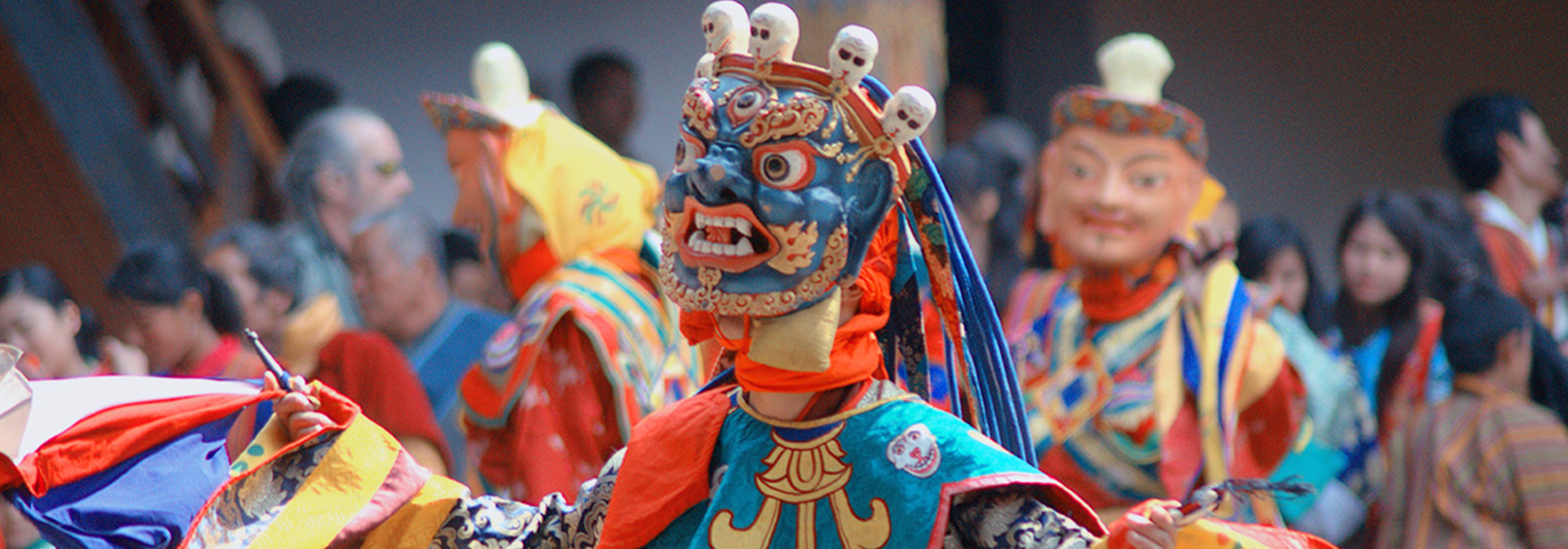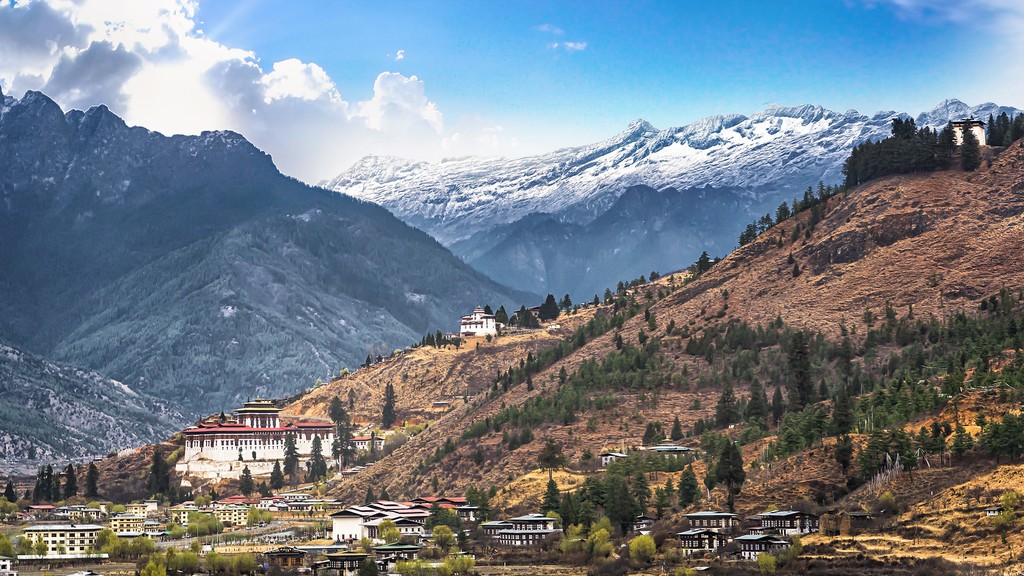
Duration: 10 Days, 9 Nights.
Locations: Thimphu, Paro valley, Punakha, Bumthang.
Type of Tour: Cultural tour/Adventure.
Highlight: Sacred 1300 years old festival, fire blessing, naked dance, spiritual tour, Visit to the Ta Dzong (National Museum), Punakha Dzong, Worlds tallest bronze Buddha statue, Tigers nest hike, 7th Century Jampa Lhakhang, Souvenir shopping at Paro and Thimphu town etc.
Description: Bhutan Jampa Lhakhang Festival & Cultural hiking tour.
Jambay Lhakhang Drup happens to be one of the most popular festivals in the hill nation of Bhutan. It has a significant place in Bhutanese culture and psyche as it is celebrated with a duel purpose and agenda. First, it is a tribute to the honour of Guru Rimpoche, a saint who introduced Tantric form of Buddhism in Bhutan.
Apart from these, the other activities include- a famous drum beat dance, a clown dance called Dola Pangtoy Shazam, Raksha Mangcham a dance symbolizing life after death and many more. With the proceedings of the events, this festival captures the attention of the onlookers and crate a magnificent spectacle.
Secondly, this festival commemorates the establishment of Jambay Lhakhang temple in 7 th century. During this festival, iety of traditional and mask dances are performed and each dance bear significant meaning. However, the highlight of Jambay Lhakhang Drup remains the fire ceremony named ‘Mewang’ and the religious dance known as ‘Tercham’.

Fly into Paro, the great snow-capped peaks of the inner Himalayas rise up to the heavens can be seen during clear weather. As the plane approaches Bhutan, if you look down farmhouses as dots on the hillsides can be seen.
As the aircraft enters the Paro valley, you will see Paro Dzong on the hillside overlooking the Paro Chu (river), with Ta Dzong, formerly a watchtower and now the National Museum, above it.
You will be received by the representative of Bhutan, who will be your Bhutan travel guide throughout your tour.
Visit the following:
Overnight at a hotel in Thimphu.
After breakfast Thimphu sightseeing’s includes the following:
After 5PM we will visit the Tashichhodzong, “the fortress of the glorious religion”.
This is the centre of government and religion, site of the monarch’s throne room and seat of the Je Khenpo or Chief Abbot. Built in 1641 by the political and religious unifier of Bhutan, Shabdrung Ngawang Namgyal, it was reconstructed in the 1960s in traditional Bhutanese manner, without nails or architectural plan.
Night halt in Thimphu
After breakfast, travel to Punakha and visit the following places.
Dochula Pass (3,088m/10,130ft) beautiful 108 chortens built on the hill by Her Majesty Ashi Dorji Wangmo for the security and wellbeing of His Majesty the King of Bhutan.
Also visit Druk Wangyel Temple which was built to honor His Majesty, the fourth king Jigme Singye Wangchuck. The past and future appear to merge in the details of the temple that tells the story of a supreme warrior figure whose vision pierces the distance future.
Travel onto Punakha, the old capital of Bhutan, Evening, walk through the Metshina Village and take a 20-minute walk through the rice fields to the Devine.
Madman’s Monastery- Chimi Lhakhang, Known for its fertility shrine, where couples unable to conceive come here for blessing.
Overnight at a hotel in Wangdue/Punakha.
Resorts/Hotels: At Punakha
After breakfast, drive to Trongsa through Wangdue Phodrang and lunch will be served enroute. Trongsa is the ancestral home of the royal family. The drive will take you through dense forests of oak trees and rhododendrons and through the tropical vegetation through the village of Nobding and Pele la pass (11,000ft).
You will also pass through open meadows, and valley of yak herders and several other villages via Chendebji Chorten (Stupa) and drive for another 2 hours to Trongsa.
Visit the National Museum which is housed in the Ta Dzong (watch tower). A museum in which aspects of Bhutanese culture and history are explained by beautifully objects. Documentary will be shown too which explains a great deal about Bhutanese history and history of monarchy.
Option: You can also visit Trongsa Dzong, which is the most impressive dzong in Bhutan. Built in 1644 by the Shabdrung, the Dzong is an architectural masterpiece.
In the evening visit Trongsa town. Dinner and overnight at a hotel in Trongsa.
After breakfast drive to Bumthang, On the way, visit the “Yathra” Weaving Centre at Zugney. Yathra is the name for the colorful, hand woven woolen cloth (often with geometric designs) that is produced in this region and wool used for this type of textile is sheep wool as the sheep is reared in the Bumthang district. Yathra is made into jackets or bags, etc.
On arrival at Bumthang Check into your hotel and after lunch visit Jakar Dzong: The fortress is now used as an administrative center of the valley and summer residence of monks. Chamkhar Lhakhang (Iron Castle). It is the site of the palace of the Indian King Sendha Gyab also known as Sindhu Raja.
Sightseeing includes visit to the following:
Jambay Lhakhang, built in the 7th century by the King Songtsen Goempo of Tibet. In his effort to propagate Buddhism he had a plan to build a total of 108 temples in Tibet and neighbour kingdoms.
The details of the first day of the festival are:
Black Hat Dance (Shana) and of the Gings (emanations of Guru Rimpoche.
Costume: Dancers, wearing long brocade robes and ornate black hats, perform this dance. The dancers’ who represent the Ging wear shorter robes with masks. This dance is performed to purify the ground and to chase away evil influences.
Dance of Offering (Tshogcham): A dancer offers the body of evil Spirits to the deities. After the offering is made the audience goes outside the temple where an arch of pine bushes has been erected.
Fire Dance (Mecham): The arch of pine is set on fire. The fire is said to purify the earth of evil spirits. People who pass through the arch have their sins cleansed. A dancer chases away the evil spirits.
Kurjey Lhakhang (Kurjey means, ”Body imprint”). The temple to the right was built by Minjur Tempa in 1652. It was built around the cave in which Guru Rinpoche meditated and left his body imprint. Tamshing Lhakhang. This temple is also known as Tamshing Lhendrup Chholing (Temple of the Good Message).
And visit Jakar Dzong. The fortress is now used as an administrative center of the valley and summer residence of monks. Later in the evening witness the festival. The first day of the festival begins in the late night.
Hike from Kurje temple to Tamshing temple. The hike is through the plain and cross the bridge and it will take around 30 minutes to conquer. Tamshing Lhakhang.
This temple is also known as Tamshing Lhendrup Chholing (Temple of the Good Message). Visit the popular Swiss cheese stall shop and enjoy the red panda beer which is brewed in the distillery nearby.
Overnight at Bumthang.
After breakfast drive to Trongsa and we will have tea at trongsa, later drive to phobjikha after lunch at chendibji cafeteria.
Optional: After lunch or in Morning visit Gantey Goenpa – This monastery is a major attraction with an old monastery date back to the 16 century.
Later walk around the valley which is also the winter home to the rare black-necked cranes, which migrate, from remote parts of Tibet, China and Siberia during winter to this valley. Jigme Singye Wangchuck National Park ( formerly known as Black Mountains National Park), one of Bhutan‟s most important nature sanctuaries. Each winter it is home to a flock of 300 rare and endangered black- necked cranes.
The surrounding hills and mountains are home to nomadic shepherds and yak-herders. This is one of the most remote and untouched regions in Bhutan and is only just opening its doors to the outside world
Overnight Resorts/Hotels at Gangtey.
Today after well rest we will drive to Paro. We will do some sightseeing on way and also stop at Thimphu for while if there are any last minute shopping.
We will stop en-route for any last minutes shopping or visit any other place as per the interest of the guest.
Later stroll through the town and rest in Resort.
Today after breakfast, we will drive to base of Taktsang and hike up to Taktsang Monastery, also known as ‘Tiger’s Nest’. The climb up to the view point will take around 1 ½ hours and from there you will enjoy a spectacular view of the monastery clinging to the side of the cliff.
Stop for refreshment at the View Point Cafeteria then walk further up to the monastery which will take about 1 hour.
It is said that in the 8th century Guru Rinpoche flew on the back of a tigress from eastern Bhutan to this place and meditated in a cave here for months.
The principal Lhakhang (monastery) of the present monastic complex dates from 1692. Taktsang was damaged severely by fire in 1998 but has now been fully restored to its former glory.
After visiting the monastery, walk back down to the road on the way stop for lunch at the view point cafeteria and then walk further down to the road point. Then drive back to hotel.
On the way, in the evening relax and overnight at a hotel in Paro.
In the morning tour guide from Bhutan will escort you to the Paro airport for your flight to your onward destinations